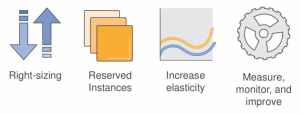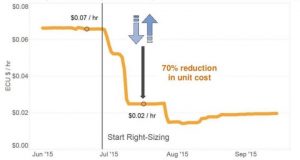Four Pillars of Cost-Optimisation in Cloud Computing
A key business driver to move to cloud in the first place for most organisation is to reduce cost incurred by on-permise infrastructure. Often times organisations undermine the complexity of cloud computing and thus one of the challenges faced after moving to cloud is on managing cost.

Four Pillars of Cost-Optimisation in Cloud Computing
Some organisation may spend more than what was planned or you would like to spend less, Cost-optimisation from cloud computing is moving from ‘pay for what you may need’ to ‘pay to what your actual usage / actual need is’.
In this article we discuss some of the pillars that organisations can consider to successfully architect their cloud solution for cost optimisation to realise the economics of cloud – Cloudonomics. (Cloud Service Management Training)

Pillar 1 – Right-Sizing
What is Right-Sizing in cloud computing? Right sizing is defined as a process of planning for “the use of electronic capacities purchased, effectively and efficiently.” Instances can be identified and by analysing CPU, RAM, Storage and Network to instances which can be potentially downsized for cost-optimisation, at the same time meeting to performance requirement. Major cloud service providers such as Amazon, Microsoft and Google have also simplified the process of right-sizing by providing elastic service models that can be expanded to meet an organisation’s needs.
Pillar 2 – Reserved Instances
Reserved Instances (RI) critical component toward building a better cost optimisation and cloud efficiency discipline. RI provide organisation with a significant discount compared to On-Demand Instance pricing. When you purchase a RI, choose a combination of the following that suits your needs: Payment options, terms, Instance type, Scope, Tenancy, Platform. With RI the organisation goes into a long-term contract from one up to three years, but in return the hourly rate is lowered which organisations can get up to 70% of savings on their on-demand instances. This provisioning is supported by Azure, AWS and Google.
Pillar 3 – Increase Elasticity
In cloud computing, elasticity is defined as “the degree to which a system is able to adapt to workload changes by provisioning and de-provisioning resources in an autonomic manner, such that at each point in time the available resources match the current demand as closely as possible”.
Elasticity principles are related to a central problem – avoiding both over-provisioning and under-provisioning. There is a fine line between not having the resources to run your application and wasting money on infrastructure you don’t need. Elasticity is all about smart, efficient architecture that finds a balance between “not enough” and “too much.”
An organisation can as well look for instances, such as test, dev or non production instances that are always running to be turned off (scale down) by means of saving cost to organisation. Cloud service providers leverage on auto scaling to scale up or scale down based on demand and usage (for example spikes).
Pillar 4 – Measure, Monitor and Improve
The fourth pillar for us to consider is a cost optimisation governance, where we uncover the cost optimisation opportunities. An organisation’s overall cost should be evaluated in the context of what outcome cloud delivers.
The impact of right-sizing

- Identify always on non-production instances such as Dev, Test and etc.
- Identify instances to downsize resources and at same time meeting to performance requirements.
- Recommend Reserved Instances, On-demand instances and Spot instances for purchases.
- Dashboard statuses on Instance and
- Report on savings
